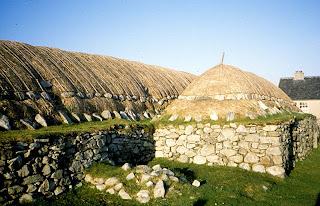
I have just come to the end of my book Sea Room by Adam Nicholson, all I can say is that it was excellent and thoroughly engrossing book. Skimming over the Shiant Island's long history like the sea birds that cluster so thickly there at certain times of the years Nicholson conveys the great sense of peace on these rocks that could just about give a living to several families, if they worked hard and did not mind the hardship of strong weathers. The fat little puffins who breed there and the great skuas, the sheep who roam so perilously close to the cliffs. Those cliffs of pillared basalt, occasionally a column would fall without warning into the sea, The Minches a sea that must be travelled over from the Isle of Lewis to the Shiants, in whatever weather sometimes you could be stranded on the islands for a long time as the winter storms raged.
There are sad stories, one particularly comes to mind when a husband and wife went hunting down the cliffs for puffins, the wife on a long rope managed by her husband caught and killed the puffins and hung them round her waist. But the rope broke and she tumbled into the water to be swept away on a petticoat of puffins, talking to her husband who could do nothing to rescue her but watch her swept out to sea buoyed up by her harvest of puffins.
There is tales of the archaeological digs by a Czech team which uncovered prehistory as well as much later evidence of pottery made on the islands by locals as late as the 18th century. Poor stuff made out of the clay to hand, fired in the hearth fire, this Craggenware pottery must have resembled the earlier Neolithic pottery.
Another funny story comes to mind, this to do with cattle, all animals would have been transported by boat from or to the main island. There is evidence of a horse jaw and a house cow was presumably often kept in the later centuries. But to return to the story, a bullock was hauled by a small crane into the fishing boat for transportation back to Lewis in the 20th century, as he swung gently in the air over the four men who were hauling him over he emptied his four stomachs over them - and in Nicholson's dry sense of humour - cattle have not been seen on the islands since!
The famous black rats of medieval England still live on all the three islands, feasting on puffins when they are around and famine sets in when the puffins have gone and they have to eat grass. They live in the one habitable house as well, scuttling across the rafters boldly peering into your face on your bed at night. So that Nicholson's womenfolk refuse to stay there, no loos, no electricity and the ever present rat.
Life on a Scottish island romantic of course in summer, in the dark of winter with the storms beating at your door and windows maybe not so. There are still remains of the black houses of the past, cosy with half of the insides for human habitation the other half for their animals over winter, the smell could not have been too pleasant, though the animal floor sloped away to the east for drainage. And in spring, the east stone wall would be knocked down and the bedding removed to fertilise the fields. The few cattle would often be starving by the end of winter and would have to be carried out to the fields, very similar to their Scandinavian brethren.
Blackhouse Museum on Lewis
You can see from the following photo how a blackhouse would look, the ropes and stones thrown over the thatch, is a method used in places round the West Welsh coastline, Aberridy immediately springs to mind.
http://northstoke.blogspot.co.uk/2012/05/territory.html
Blackhouse Museum on Lewis
You can see from the following photo how a blackhouse would look, the ropes and stones thrown over the thatch, is a method used in places round the West Welsh coastline, Aberridy immediately springs to mind.
 |
| Black House reconstruction; Creative Commons with no attribution |

I'm reminded of the 'winter madness' mentioned in several books compiled from the journals and letters of women homesteaders living in the interior US western plains during settlement--the immense loneliness and feeling of endless wind and winter.
ReplyDeleteI think when visitors came from England in the 18th century onwards they found the people looking very wild and unkempt. There is a lovely story though, which I did not write about. Happening in the 18th C two beautiful unmarried daughters kept on the island by their mother, though both had babies in their single state.
ReplyDeleteInteresting the thought of 'winter madness' though.......